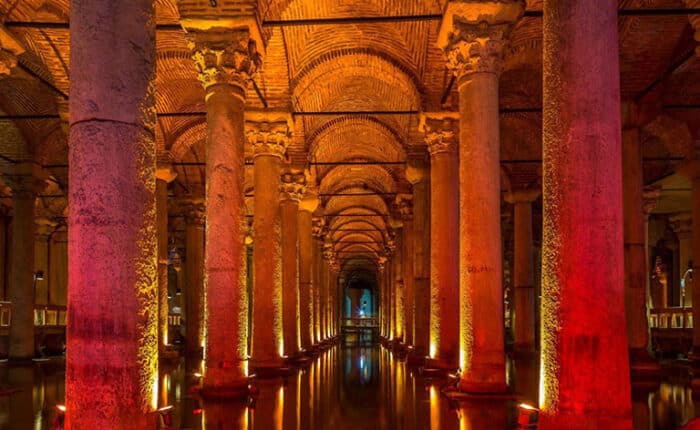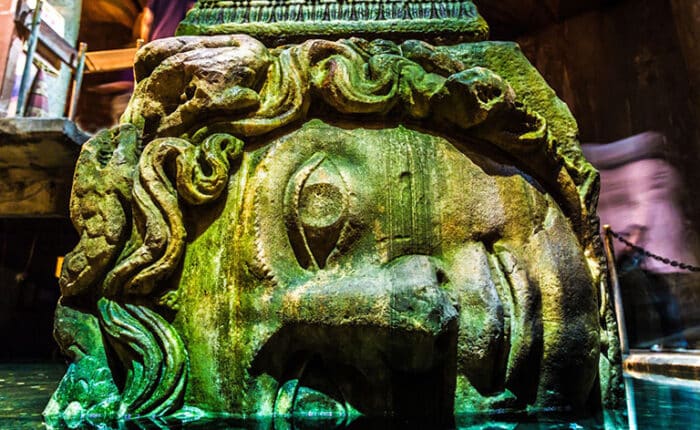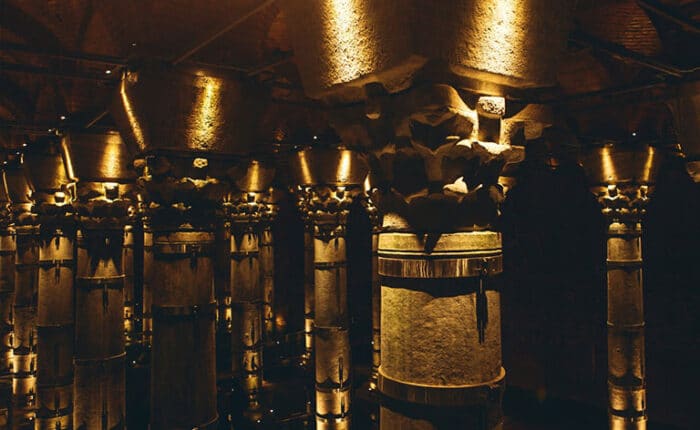The Basilica Cistern dates back to the Byzantine Emperor Justinian I, who commissioned its construction in the early years of his reign. This was when Constantinople was still recovering from the devastating effects of the Nika revolt, which resulted in the destruction of much of the imperial city and the killing of 30,000 rioters by the Emperor’s troops.
As part of the rebuilding efforts, Justinian commissioned the construction of the cistern in the year 527. The massive structure was completed 38 years later, and it served as a water reservoir for the Great Palace in Constantinople. Water was supplied from the Egrikapi Water Distribution center in the Belgrade Forest.
During the Ottoman era, the cistern was used for a while and was later forgotten for centuries before being accidentally rediscovered in 1545.
The design of the cistern resembles that of a massive basilica. However, the name “Basilica Cistern” has more to do with the fact that it was constructed next to an actual basilica than with its architectural style.
With that said, the cistern is a marvelous achievement of industry and ingenuity. The structure is 143 meters long and 65 meters wide, making it bigger than the standard football pitch. The roof, complete with arches and everything, is supported by 336 Corinthian and Ionic marble columns. Each of the enormous columns measures 9 meters in length, and they are spaced at four-meter intervals and arranged in 12 rows and 28 columns.
Apart from its sheer size, one of the most intriguing features of the Basilica Cistern are the two Medusa heads in the far left-hand corner. The heads are used as column bases; one is tilted to the side while the other is positioned upside down, which adds to their already mysterious stature. No one knows their origin or why they are positioned as they are, but there are still a few rumors that attempt to solve this mystery.
According to Greek mythology, Medusa was one of the most beautiful women of her time. Nonetheless, certain events (there are two versions) led the goddess Athena to curse Medusa into a gorgon whose gaze could turn men into stone even after Jason decapitated her.
In ancient Greek, it was believed that Medusa’s head could avert evil, and one rumor attributes this belief to the use of the two Medusa heads in the underground cathedral. Nonetheless, it could be that they were used because they fit perfectly with the columns.
Some interesting features of the cathedral include:
When visiting the Basilica Cistern, here are a few tips for you:



The Basilica Cistern sits in the historical Sultanahmet square, and getting there is quite easy. If you are using public transportation, you can get there via a public bus to Eminonu and take a walk to the cistern. The other way to get there using public means is by using the tram running between Kabatas and Zeytinburnu. Alight at the Sultanahmet stop between the Blue Mosque and the Hagia Sophia, and from here, getting to the cistern is just a short walk.
The cistern is open seven days a week; therefore, don’t put too much consideration when planning if it is the only site you will be visiting for the day. On regular days, it opens its doors at 9 am and closes them at 5.30 in the evening. Nonetheless, the opening times change during days of Turkish religious festivals, so watch out if you are visiting during these times.
Once you are there, the entrance fee is 30 TL for foreign travelers, 15 TL for local adults, and free for children under 7 years. Also, you will need a museum card to enter the structure. To avoid all of the hustle, the best way to get to the Basilica Cistern and access it is to book a Made in Turkey Tours tour package. Once you buy one of our tour packages that include the Basilica Cistern, we will handle everything, including transportation and entrance fees.
You will only be able to truly appreciate the beauty of the Basilica Cistern once you descend the 52 stone steps and pass the entrance. The massive structure imposes an equally massive aura of peace on its visitors, and the soft lighting at the column bases is a stunning addition to the cathedral. The lights give the water a beautiful red hue that makes an incredible sight for pictures.
One particular column, the Hen’s Eye column, is a must-see. It is engraved with pictures of a hen’s eye, tears, and slanted branches. The tears on the beautiful column are believed to have been a tribute to the hundreds of slaves who lost their lives during the construction of the cistern.
There are still shallow waters in the cistern, but wooden walkways have been installed to let visitors explore the massive columns. The shallow waters also mean that you will be unable to row a small boat around the cistern as James Bond did in the 1963 film From Russia with Love, which was by the way shot in the Basilica cistern. Another blockbuster movie shot in the cistern is Inferno, a film based on Dan Brown’s novel by the same name.
The waters may be too shallow for a boat, but they are still deep enough for some fish to live in. These fish are another great sight you should watch out for as you walk the cathedral columns.
The Basilica Cistern is located in the Sultanahmet Hippodrome, home to many other breathtaking attractions. These include the Hagia Sophia, Blue Mosque, Hagia Sophia, and Topkapi Palace, a walking distance from the cistern. This is why it is essential to include these other attractions in your tour.